Background
The hope of decentralized organizations is to create structures that are resilient and flexible – instead of a rigid structure that breaks under pressure, we want a structure that adapts and can repair itself. Sociocracy is one of the systems with distributed authority and decentralized ways of adapting to new circumstances.
Writing this article in mid April 2020, no one on the planet needs a recap of what happened. I was traveling for work in Europe when the Covid crisis got serious, cut my trip short and made it home to Massachusetts, just before travel bans were put up by several countries. Everyone, collectively, was trying to catch up to adjust to quarantine and all the down-stream effects on all aspects of our lives. The Covid-2019 quarantine is a good example for new circumstances – so how did sociocratic organizations do?
I was able to observe the dynamics first hand in two sociocratically run organizations that I am a member of.
- One is my full-time employer, Sociocracy For All, a remote, global non-profit with 4 staff and dozens of volunteers; luckily, our main source of income is online classes.
- The organization is the place where I live in a self-organized way with 70 neighbors and lots of shared assets like a large community building with shared mailroom, laundry facilities etc.
This article highlights some of the observations I made, both struggles and strengths.
Challenges
When we put stress on a system, all the weak spots become more visible. Although this learning is not surprising, it sure was enlightening to see it play out!
In the case of the living community, the most interesting case was an aspect of the community had never needed much attention – and now needed quick decisions. What caught us by surprise was that those areas of responsibility hadn’t been on our radar and therefore responsibilities weren’t clear.
The case of the courtyard
Example: in the living community, there is a Common House – overseen by the Common House Circle. There is also a circle for garden and landscape, a circle for infrastructure like paths and roads as well as a Community Life circle (with several sub-circles) for the interpersonal domain. Yet, the courtyard in front of the Common House had always just existed. No one needed to make policy about it. Now some people started meeting there (with appropriate social distance) on a regular basis. Others thought this wasn’t a wise idea. And the question arose: who decides? Whose domain is the courtyard in? Can the courtyard be “closed” like the Common House? Or is this an interpersonal issue? Is this a personal choice or a community issue? While one can make a point for each of those answers, the point is, it wasn’t clear and it was curious to see how a courtyard that had always been there could pose a new question. The courtyard was an undefined gap.
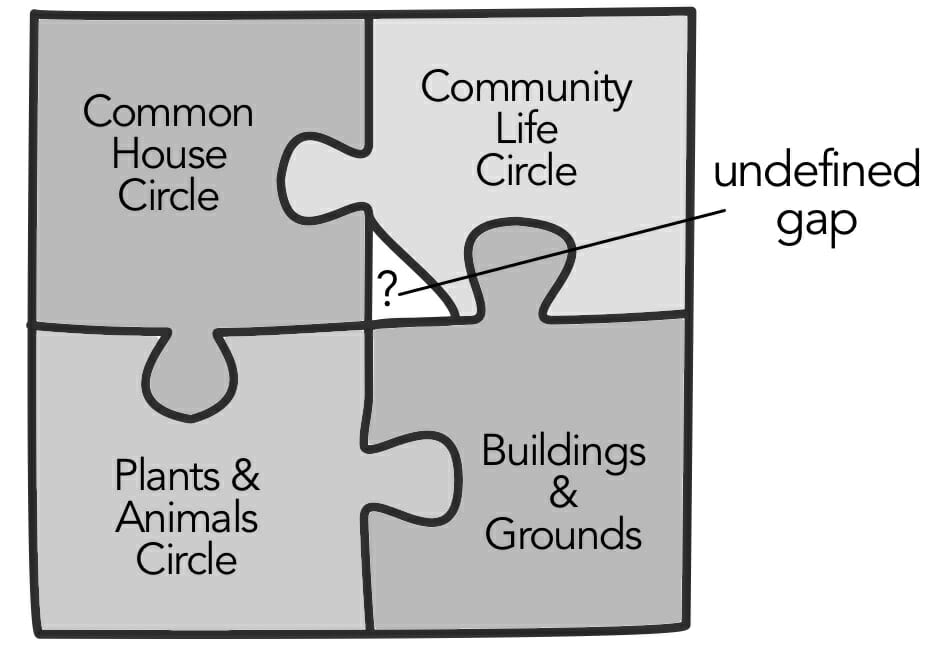
Lacks of clarity in domains are not uncommon, and sociocracy has a plan for that! The standard way of addressing it is for the closest parent circle, in this case the General Circle, to notice and clarify the domain. Which is also what happened when a decision was made who would be in charge of the decision.
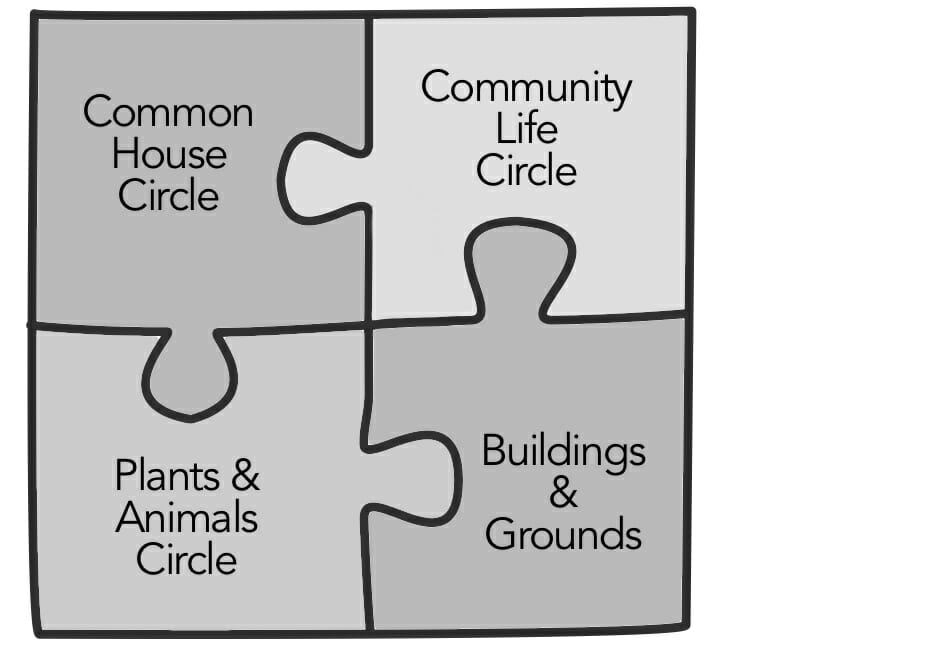
The training issue
Yet, of course, someone needs to be aware that a domain is “unclaimed” and needs to make sure this gap is filled. The people that happened to be in key positions in the moment hadn’t really understood the process of clarifying and distributing domains. It’s a training issue that all volunteer organizations are familiar with. Many people know a lot but really, for a self-organized system with full distribution of authority to work, basically everyone needs to understand the system well. The fact that this wasn’t the case cost us some time and created some friction – we could have been faster at noticing the courtyard gap. Training is crucial, and we can’t rely on too few individuals to help us out. If we distribute authority to many members, we also need to make sure many members are trained. Everyone with authority needs to be trained!
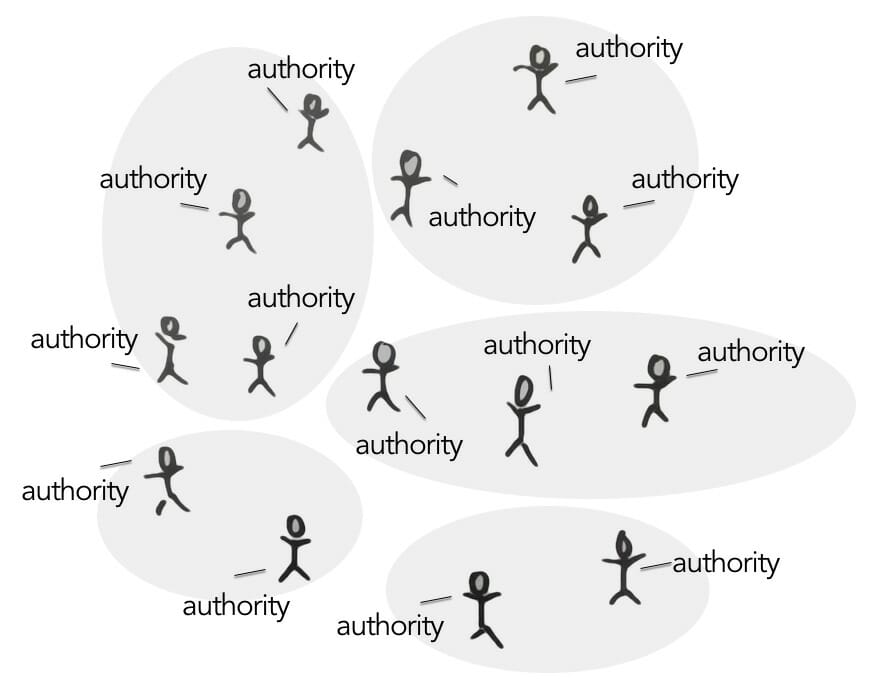
This is a vulnerable point of any organization with distributed authority! To make my point even clearer, the above picture (people having authority) has to translate into the below picture, or it will fail in the long term or under strain.
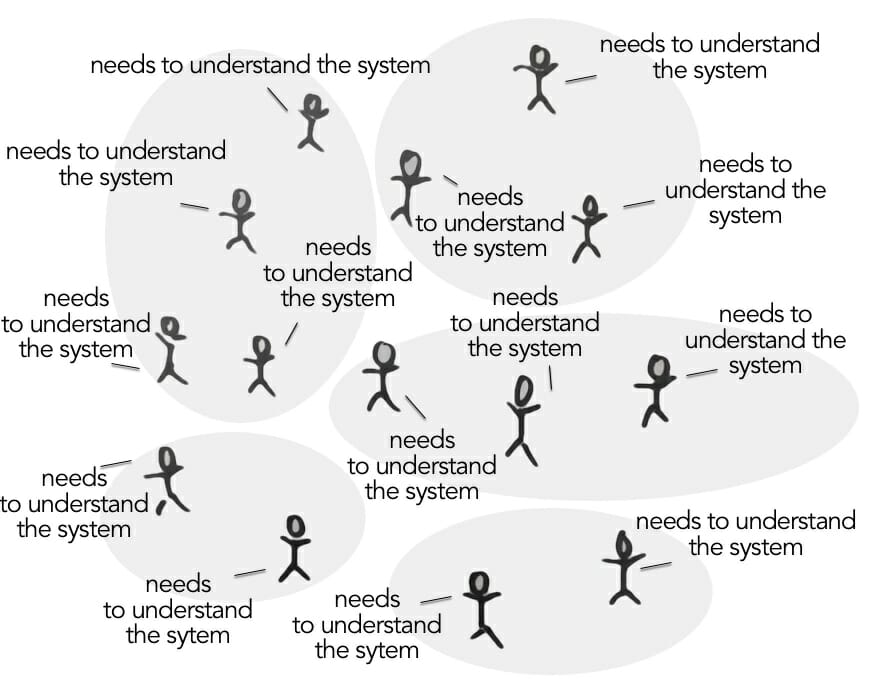
Note: in the non-profit, I haven’t seen any of these effects. We simply continued working. Which speaks to the fact that lack of experience with governance is a factor – since everyone in the nonprofit knows sociocracy inside out, there was no struggle with the system! Also, the need for immediate action wasn’t as big – we weren’t in close proximity and therefore health and safety weren’t a factor in our collaboration. So we had it easier in the business than in the community.
Strengths
1. Strong relationships
Maybe the biggest strength of both organizations in dealing with the challenges in this situation was the solid foundation of personal relationships. Even tensions that came up were embedded in a context of deep connection. This means that the organization was able to self-repair – there has been reaching out and working towards mutual understanding. Some circles that took some heat for unpopular decisions were showered in appreciation later in a shared connection meeting. In short, the hours invested in listening and building of relationships pay off when decisions need to be made with less time available to talk!
In the community, a clear strength was that there is a system for conflict resolution already in place – the Care and Counsel Circle. Interpersonal tensions that came up as people were going through their own process of adapting to the new situation could be mitigated with mediations and listening session that are already part of the common practice and DNA and had been established and used long before.
While a commitment to human connection can be taken for granted in a community, would this be different in a workplace and volunteer place? One side-effect of the crisis was the fact that several employees and volunteers have their school children at home – maybe that is, beyond some loss of revenue, currently the biggest strain. Yet, planning around child care schedules and having kids walk into work phone calls was not unusual previously and continues to be a challenge that is met with understanding and flexibility. What binds everyone together is a strong sense of purpose and a desire to be real and authentic – and children are simply a fact of life. Logistics were figured out together without judgment.
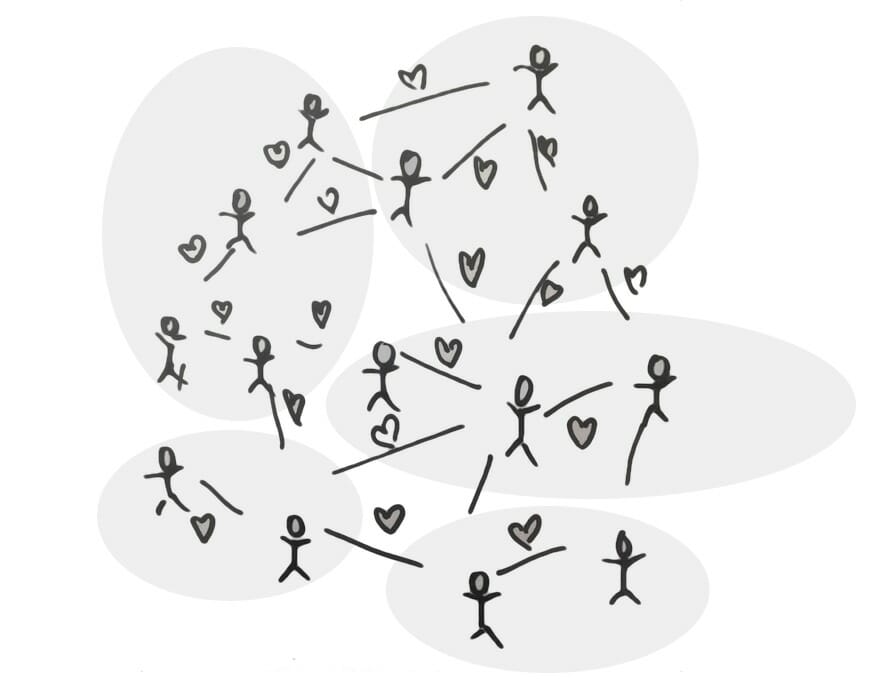
In the non-profit, the level of personal check-in texts and emails increased, and people made time for each other. Even a circle of students that was part of a training decided to ditch their agenda (by consent) and to spend half of the meeting time on listening to each other for empathy. It’s what needed to happen in that moment, and people were able to adjust the previous plans and make room for the moment. Giving teams the power to shape their meetings meant that each team had the opportunity for deep connection.
2. Local responsiveness, and the freedom to act
Another strength was that people were able to adapt to the new situation in many different places. In the non-profit, every circle addressed the crisis as an agenda item and reflected on how the new situation affected their particular domain. Training Circle made the guess that people would sign up for shorter one-time classes rather than commit to ongoing classes and made changes in the program. Support Circle evaluated whether there would be issues in our resources if all staff members would lend their personalized business zoom accounts to other projects. SoFA General Circle had a conversation on “what do we have to offer that’s needed by others right now?”, and “what were we planning to do that seems obsolete now?”. Like a living organism, the nonprofit was able to adapt not as one but as many parts, each group an expert on their piece of the work and with full authority to make changes in operations and policy as they saw fit.
In the community, it took a little while until all circles had woken up to the fact that their action was needed. Yet, then things got done quickly: Common House Circle made sure to prevent spreading of disease in the shared mailroom and laundry room; they were able to make that decision fast because they understand their domain and because they have the authority to do so without having to ask for permission because they were empowered to do so. Other circles adjusted as well, for example by changing the way workdays were run so people could still do work yet at different times.
The case of the CH closing
In the case of the Common House, interestingly, at first, the circle was not able to meet timely enough to make a decision together. What ended up happening was that the leader of the circle made an executive decision to declare the CH closed until further notice. While this was not welcomed by everybody, the feedback lines were always clear because they were already established. With some people upset about the decision, Common House Circle got overwhelmed with feedback and limited their availability for feedback which makes sense: when everyone is stretched thin because of many extra meetings and more emotional strain, it’s harder to listen. This again, was not received with appreciation by everyone. On the other hand, if one thinks of listening and action as waves (first we do what needs to be done, then we listen later, act again and listen again), the effect of not-quite-listening evens out over time. If we think of a resilient governance system as a natural system, it was bent temporarily but it didn’t break.
The General Circle had a short moment of wanting to centralize power to respond to the crisis, but as soon as working circles were able to take on their domains, General Circle was able to “lean back” again. As the “shock-wave” was absorbed, power was immediately distributed more evenly again, like a rubber band that was stretched but quickly eased back to its regular structure.
3. Flexibility: Top-down, Bottom-up and adopted circles
Another strength in sociocracy is that there are many ways in which the structure can adapt – circles can grow top-down or bottom-up. In the community during the beginning of Covid19, we had both, two examples of “spontaneous” groups that got integrated, and one top-down circle that was formed.
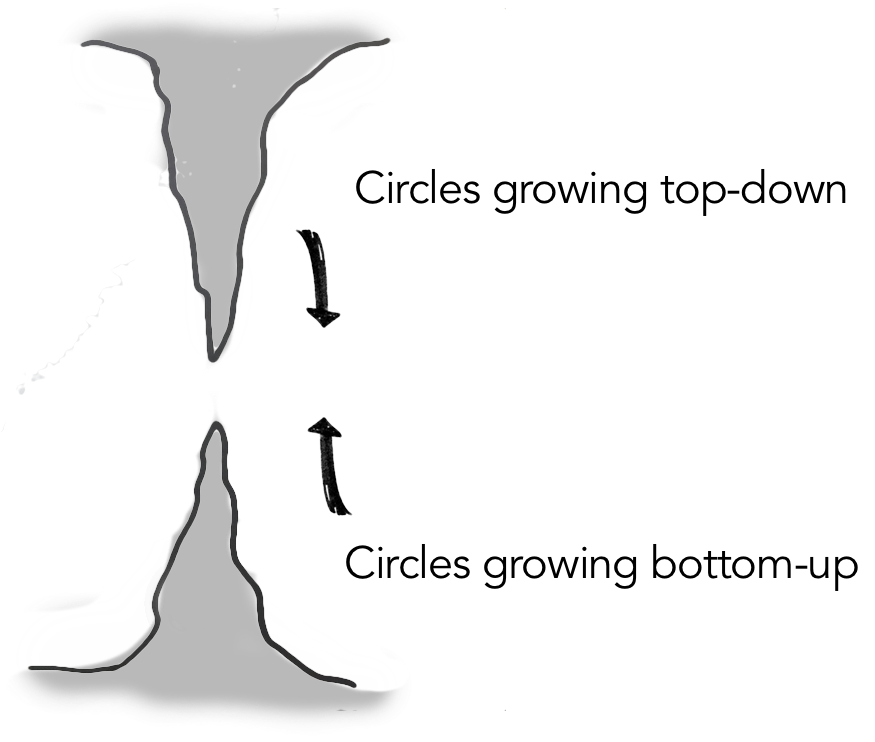
Bottom-up circles
The case of the “Covid prep group”
One example of a circle forming bottom-up was a “Covid prep group”. This circle had not been formally formed by any other circle, it simply formed organically based on shared interest. The circle was, as would make sense in sociocracy, only an advisory group, with no own decision-making power on policy (i.e. with no domain of its own). Although it was originally formed “outside” of the governance system, it showed the spirit of self-organization, collaboration and care for each other.
Later on, more clarity was desired. In order to funnel the research & recommendation from the Covid prep group into the policy-making group(s), the Covid prep group was “adopted” under Community Life and a double link was instituted between the two circles to ensure good flow of information. Note that the circle wanted to be adopted to make sure it can be relevant, and the parent circle wanted to adopt to make sure it could use the expertise well – so it was easy to find consent to this decision.
The case of the pods
Another example of organic bottom-up growth was that Covid prep group (before being adopted) instituted “pods” of neighbors to make sure we could build a system to check in on each and every neighbor. These pods formed, and Community Life Circle later adopted that newly formed domain as well.
New sub-circle
While some structures grew bottom-up, there was also an intentional top-down strategy to close a gap. In this case, it was clear that the Covid prep group wouldn’t have the bandwidth to take care of people sick care. To meet the need, its parent circle Community Life formed a Covid Sick Care group that would be able to prepare sick care for the contagious virus. The circle was formed in a way so that the key teams working on health (Community Life and “covid prep group” as well as another sub-circle of Community Life) would have a direct connection with the circle, making sure there would be synergy and fast communication.
On the nonprofit side, not much adaption was necessary in the structure. This might change in the long run, as the budget will be affected. Yet, decisions about the allocation of resources will be made by the consent in the General Circle so there is no one individual or group will be able to make a decision that violates the other circles’ needs. If tough decisions will have to be made, they will be made together with a voice for every team member in the General Circle and with input from all circles. The minutes of the General Circle are always public to the whole membership so they will be transparent to all members.
Conclusion
This was quite a ride! As for sociocracy and emergency response, I was glad to see how many options to adapt it allows, how the system self-corrects and never seems to be in the way, especially when people understand it well and are able to tailor it to their needs in every moment and circumstance, almost in real time.


Leave a Reply
You must be logged in to post a comment.